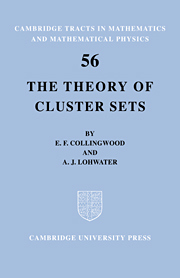Book contents
- Frontmatter
- Contents
- Preface
- Chapter 1 INTRODUCTION
- Chapter 2 FUNCTIONS ANALYTIC IN A CIRCULAR DISC
- Chapter 3 TOPICS IN THE THEORY OF CONFORMAL MAPPING
- Chapter 4 INTRINSIC PROPERTIES OF CLUSTER SETS
- Chapter 5 CLUSTER SETS OF FUNCTIONS ANALYTIC IN THE UNIT DISC
- Chapter 6 BOUNDARY THEORY IN THE LARGE
- Chapter 7 BOUNDARY THEORY IN THE SMALL
- Chapter 8 FURTHER BOUNDARY PROPERTIES OF FUNCTIONS MEROMORPHIC IN THE DISC. CLASSIFICATION OF SINGULARITIES
- Chapter 9 PRIME ENDS
- Bibliography
- Index of symbols
- Index
Chapter 6 - BOUNDARY THEORY IN THE LARGE
Published online by Cambridge University Press: 06 November 2009
- Frontmatter
- Contents
- Preface
- Chapter 1 INTRODUCTION
- Chapter 2 FUNCTIONS ANALYTIC IN A CIRCULAR DISC
- Chapter 3 TOPICS IN THE THEORY OF CONFORMAL MAPPING
- Chapter 4 INTRINSIC PROPERTIES OF CLUSTER SETS
- Chapter 5 CLUSTER SETS OF FUNCTIONS ANALYTIC IN THE UNIT DISC
- Chapter 6 BOUNDARY THEORY IN THE LARGE
- Chapter 7 BOUNDARY THEORY IN THE SMALL
- Chapter 8 FURTHER BOUNDARY PROPERTIES OF FUNCTIONS MEROMORPHIC IN THE DISC. CLASSIFICATION OF SINGULARITIES
- Chapter 9 PRIME ENDS
- Bibliography
- Index of symbols
- Index
Summary
Method of the inverse function
Important results are obtained by studying the inverse z = z(w) = f-1(w) of the analytic function w = f(z). These results turn for the most part upon the relationship between the singularities of the function z(w) and the set Г(f) of asymptotic values of f(z). We therefore begin this chapter with a brief account of those properties of the inverse function which we shall require.
We write w = f(z). Then, to any z0 in the domain of existence D of f(z) there corresponds a power series ez0 = ez0(w, w0) in (w-w0)1/k having a positive radius of convergence, where w0 = f(z0) and k ≽ 1 according as w0 is a simple or multiple value of f(z) at z0. We may assume that z = ∞ is not contained in D so that z0 ≠, ∞ ez0 contains no negative powers, and w0 is not a pole. If z0 is a pole, w0 becomes the point at infinity and ez0 takes the form of a power series in (l/w)1/k. This distinction, awkward in the case of a meromorphic function having an infinite number of poles, is obviated in the usual way by projecting the w-plane stereographically onto the sphere of unit diameter tangent to the plane at the origin—the Riemann sphere. If k = 1, the series ez0 maps the interior of its circle of convergence cz0 conformally onto a domain d(z0) containing z0 and containing no zero of f'(z), the derivative of f(z).
- Type
- Chapter
- Information
- The Theory of Cluster Sets , pp. 114 - 132Publisher: Cambridge University PressPrint publication year: 1966



